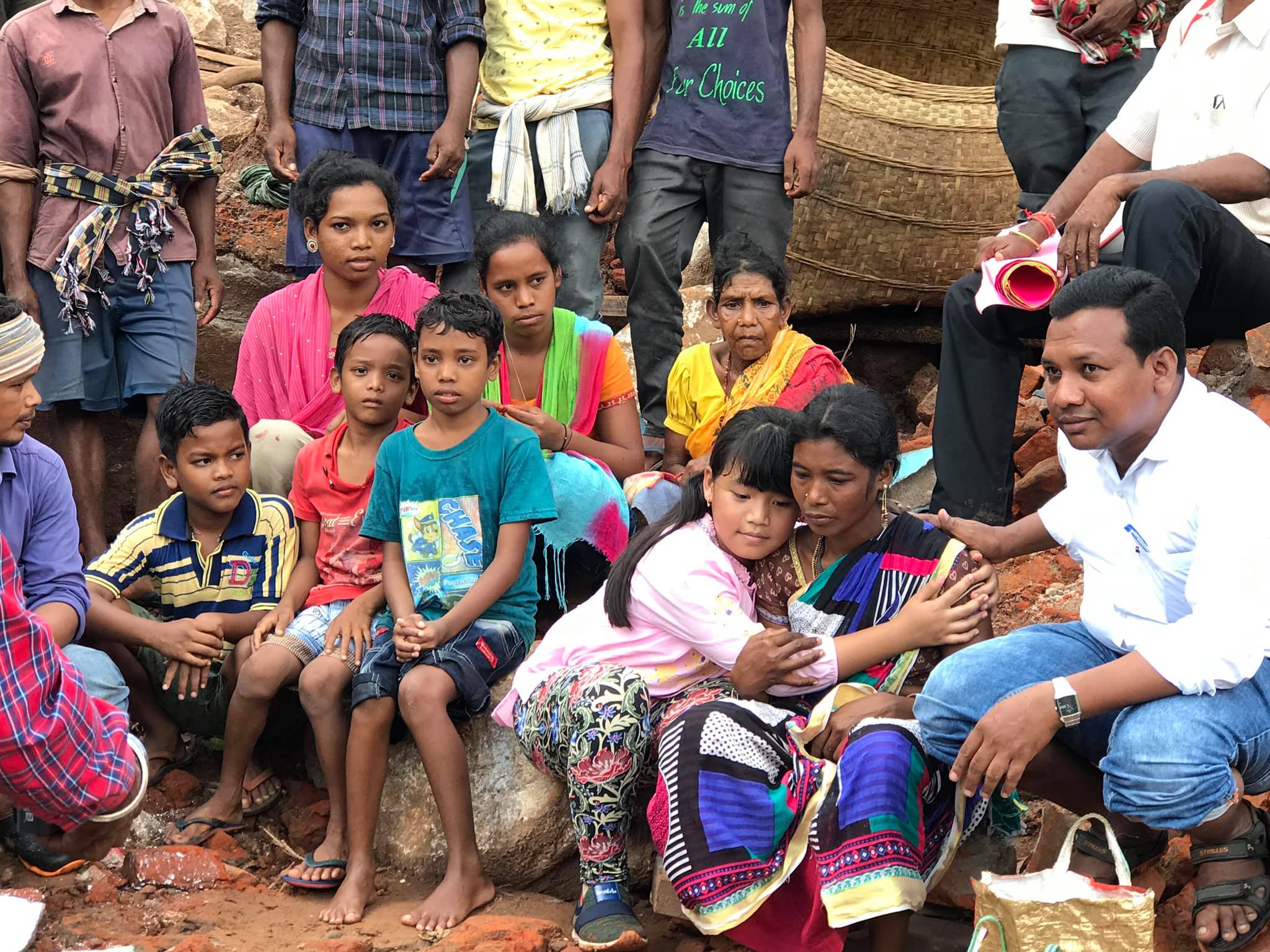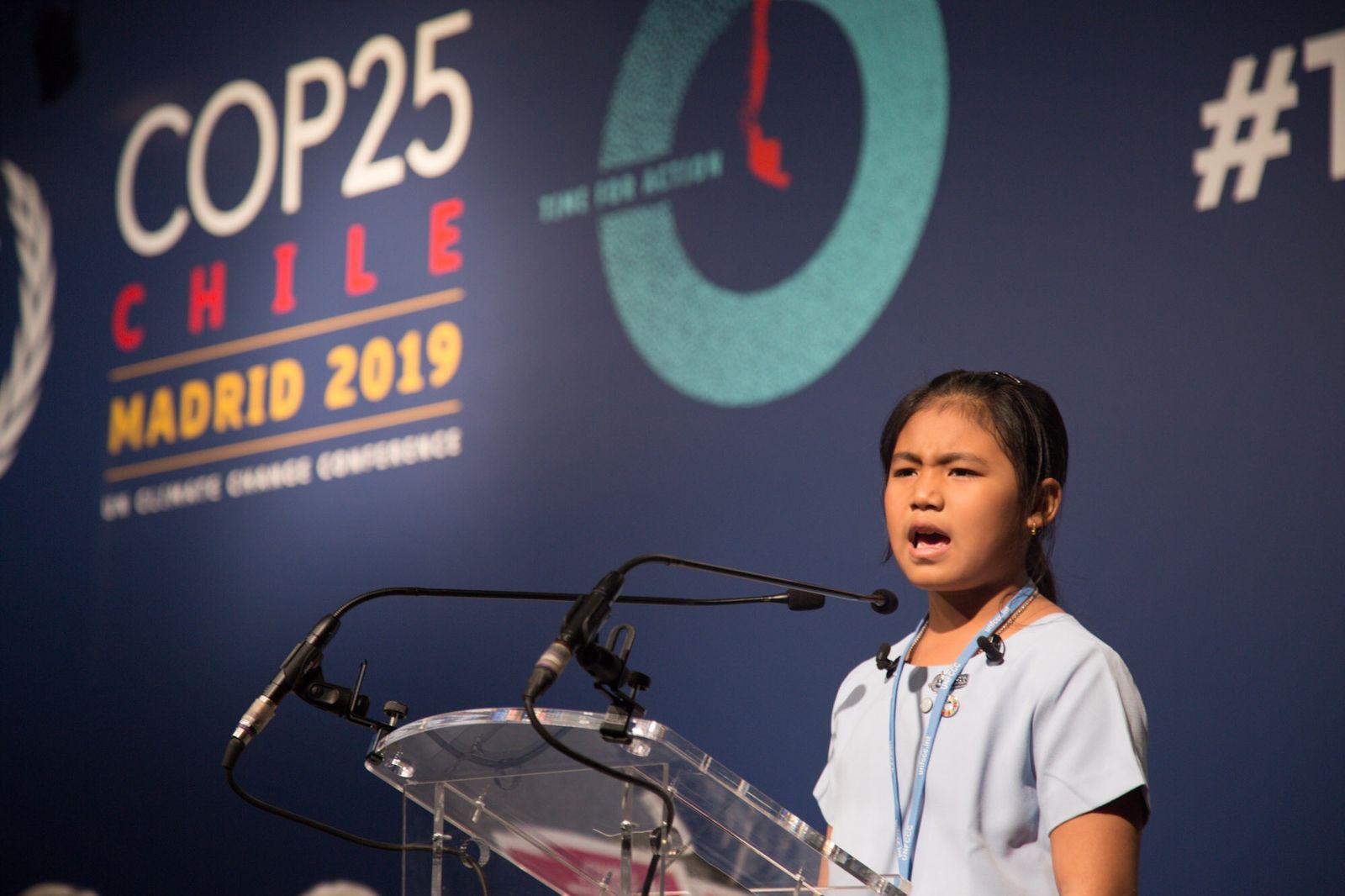Licypriya Kangujam is an Indigenous climate activist from India. At nine years old, she spoke at the United Nations Climate Conference (COP25) in 2019 and traveled around the world to speak at climate and international conferences. Kangujam has been recognized for her advocacy for clean air initiatives and protests against the Indian government.
HIR: You’re by far the HIR’s youngest interviewee ever at just nine years old. How did you get your start in climate advocacy?
Kangujam: Thank you so much for this opportunity. I’m glad to hear that I’m the youngest interviewee in your history.
I was born in a small village of Manipur in North East India surrounded by lush green mountains and an alluring atmosphere. I never realized what I’m doing is activism until 2018 when people started calling me a climate activist. In 2016, I came to Delhi for the first time for my schooling, but my life became very messy due to the high air pollution level. Later, I moved to Bhubaneswar, Odisha, in the same year for my schooling. Again my home in Odisha was hit by Cyclone Titli in 2018 and Cyclone Fani in 2019. These incidences in my life turned me into an outspoken child that talks about the impact of climate change to our leaders when they failed to act on it.
The Nepal Earthquake of 2015 is also an important event in my life. During that time, I accompanied my dad to raise funds to help the victims’ children and families. That was the first time that I learned the words “climate change” and “natural disasters,” but I couldn’t realize what exactly they were as I was a small baby that time. But, this could be the main reason why I am so concerned about the environment and our planet.
My father did his Masters in Environmental Studies in Nalanda International University. He frequently talked to me about various environmental issues happening everyday around the world. It also helps me to learn and understand many things about the environment and climate change. Unfortunately, he couldn’t complete his degree in the university, but he wishes for me to love and be concerned about our nature and our environment.
In July 2018, when I was just six years old, I got an opportunity to attend the United Nations Disaster Conference in Mongolia. It was a life changing event.
Just after I returned back home from Mongolia, I started my organization called “The Child Movement” in July, 2018 to call on world leaders to take immediate climate action to save our planet and our future. It has now become a people’s movement for climate justice in India and various other countries.
My first parliament protest was on February 2, 2019. I have my three main demands to our leaders and the Government to change the system: to pass the climate change law in the parliament as soon as possible, to make climate education compulsory in every school in India, and to ensure plantations of minimum of 10 trees by every student in India.
If they pass the climate law then we can control carbon emissions and greenhouse gases. Also, it will give climate justice to millions of poor vulnerable people and other marginalized communities who are the victims of climate change. It can bring accountability and transparency to the government.

Making climate education mandatory in schools' curriculum will help to fight the climate crisis from the grassroots. Italy has already made climate education compulsory in their school curriculum since 2019. If India follows suit, India will be the second country after Italy to take such initiative in the history of the world and the first in Asia.
India has over 350 million students. If 350 million students plant a minimum of 10 trees every year, then we will plant 3.5 billion trees every year. Trust me; India will be green within five to 10 years. This will help fight the air pollution, floods, droughts, heat waves and other environmental issues in the country.
I dropped out of school as of February 2019 due to my protests every week in front of the parliament house. My parents couldn’t afford the expenses for traveling every week from Bhubaneswar to New Delhi for my protest, so I decided to drop out of school. It was the most disappointing period of my life. I missed my school, my friends, and my teachers.
Before my parliament protest, I moved from place to place to create awareness on climate change, specifically targeting children and young people and also attended various global important meetings to raise my voice.
I addressed the world leaders at the United Nations Climate Conference 2019 (COP25) held in Madrid, Spain. It helped me to amplify my voice globally.
So far, I have traveled to about 32 countries as a part of my movement and spoke in more than 400 institutions and platforms to advocate adults on climate change as a speaker across the globe in the last two years. When I began the movement, I was alone, but today, I have thousands who love and support from across the globe.

HIR: What is the value of youth advocacy in the climate movement? What unique perspective do you bring?
Kangujam: Some of the changes I brought to my country through advocacy are as follows:
1) New Air Pollution Law in India:
It’s one of my long-standing demands for our leaders over the past two years. I played an important role to bring about this new law to curb the air pollution crisis in Delhi. I protested in front of the President House at midnight on October 15, 2020. I was detained by Delhi police on October 18, 2020. On October 28, 2020, the President of India signed and approved an ordinance to enact this new air pollution law in India in five states. The Prime Minister of India also ordered that a new commission be established on air pollution with its headquarter in Delhi to solve the Delhi air pollution crisis permanently. As per the new law, polluters can be fined US$134,000 or be jailed for up to five years.
2) Inclusion of climate change as a compulsory subject in School Education Curriculum:
So far, the Indian states of Rajasthan, Gujarat and Sikkim have given me positive responses. Starting from zero, now over 145,000 schools in India will include climate change as a compulsory subject in their curriculums. Still I need to wait more and see. Now India becomes the second country after Italy to take such initiative in the history of the world. And, over 1000 private schools have already started taking this initiative across India and many other parts of the world after my request.
3) 1 Year 1 Million Trees:
I have planted over 350,000 trees in my life in various places across India and many parts of the world with school children, which is equivalent to planting 100 trees every day since my birth. I plant thousands of trees every week by celebrating “Monday for Mother Nature” with children of various schools across India and others to make our planet green again with the mission of plating one million trees each year as a part of taking climate action from the grassroots.

HIR: Indigenous communities around the world have been vocal about the impact of climate change on their livelihoods. As an Indigenous girl, why is climate change an Indigenous issue? Is there room for solidarity between the climate movement and Indigenous rights movements?
Kangujam: Indigenous people are playing a crucial role in protecting our planet. We are not on front covers, but we are the first line of defenders. Due to rising violence against Indigenous communities around the world, it’s an alarming situation for all of us along with the bigger challenges of protecting our forests and the environment. Even in my home state, the government has given licenses to big foreign companies based in the Netherlands to exploit our indigenous forest for oil exploration while local people are opposing it. Many Indigenous activists are in jail or are even murdered in several places across the world. Denial of the climate crisis by our leaders increases the threat to us. As both the climate movement and Indigenous rights movement are fighting for the common cause, it’s time to come together to strengthen our movement with one common voice to protect our rights and to defend the defenders. We are interconnected and interdependent. The climate movement will fail without indigenous people.
HIR: India, your home country, is a major carbon emitter, but also a developing country. How do you respond to critics who say that developed carbon emitters like the US and countries in the EU should be the ones involved in climate advocacy as opposed to countries like India?
Kangujam: Climate change has no border. India is also equally responsible for the global carbon emissions. Developed nations should invest more for a green economy as compared to developing ones, but India can lead and be a role model in fighting the climate crisis because we have full potential to do so. Besides the EU and the United States, two of the highest global carbon emitters like China and India are two giant neighboring countries and they’re not doing enough. They are still giving huge subsidies to fossil fuel companies, which are responsible for massive carbon and greenhouse gases emissions globally.
I’m very much confident and I expect a lot from United States President-Elect Joe Biden’s leadership. We are going to hold him accountable. Yesterday, I was so happy when I heard the news that our Prime Minister Narendra Modi discussed climate change with Biden. I was a little bit surprised too because it never happened in the last four years of the Trump administration.
India needs to see climate change as an urgent political issue. India is already experiencing adverse extreme weather events like floods, droughts, heat waves, cyclones, and locusts in addition to extremely polluted air and water stress at the same time. These are all the impacts of climate change. India must take a leadership role in the shift to sustainable production and consumption to end this crisis and the shift from a carbon economy to a green economy. India must create policy that encourages resource efficiency and a reduction in waste of resources. In doing so, it will provide a template for other developing countries as well.
India must build on international initiatives it has piloted, such as the International Solar Alliance to further global cooperation and collaboration to address climate change. India should bring the United States into the International Solar Alliance. Working with partners in the developed and developing world, New Delhi must take the lead and be instrumental in shaping global climate efforts.
As the United States and India work together, the United States must demonstrate that they feel an obligation to act ambitiously to cut greenhouse gas emissions given America’s level of economic development and the current size and the historic volume of US emissions.
The United States and India can also scope out areas of cooperation, including advancing green investment, cooperating on solar and wind technologies, cooperating on forest policy; especially conservation and accounting, cooperating on climate resilience (drought, flood and coastal lines), and developing state-to-state and city-to-city cooperation on resilience, mitigation, monitoring and assessment.
The United States and India can do more together, and we must do more together. We have to do it faster otherwise our planet will be dying soon. The world needs a concrete climate action plan to save our planet and our future.

HIR: You have advocated for climate education in schools. What would this look like? Why is climate education important?
Kangujam: I receive a lot of positive responses both from state governments and schools. It’s become a movement now. Over 1000 private schools in India and many parts of the world are now teaching climate education in their schools. In each school, there are a minimum of around 3000 to 4000 students, and some schools are run under a society and they have dozens of branches across the country. So, it’s easier for me if their founder or the head of the society accepts my proposal without approval from the government.
Climate education is very important if we really would like to fight the climate crisis. Adults are not doing enough already, and I don’t have much faith in them to come to the frontline and save our planet and future. The last hope is children. If we include climate education in schools, then we can fight climate change from the grassroots. It will help to educate adults and our leaders via their children and grandchildren, so that we altogether can support each other to save our environment and our planet. This also increases environmental consciousness among the people in addition to a love and respect for nature. I am even preparing to go to court to direct the government to include it as mandatory in all national curriculums of various school boards. I trust it will be a very successful mission.
HIR: India experiences many extreme weather events that have been linked to climate change from floods to heat waves. What can be done to prepare the country better for these devastating events? How do you approach this in your advocacy?
Kangujam: India is the sixth most vulnerable country in the world to climate change. We are facing floods, droughts, heat waves, cyclones, and air pollution all at the same time. These are all the impacts of climate change. We need to shift to a green economy from a carbon economy. The government needs to make strong new climate laws to protect our environment. We need to promote clean energy like solar in cities and wind turbines in rural areas for power instead of depending on coal. We need urgent green transitions from fossil fuel vehicles to electric vehicles. We should also stop deforestation for mining and developmental activities. I have written several letters to our leaders and officials, submitted memorandums multiple times, and held protests to draw their attention. I also use social media, like Twitter, as a powerful tool to address the voice of the people to our leaders.
Some people always tell me that I’m too young to get involved in such activism, but I am proof that age doesn’t matter to make a difference. Big or small, it doesn’t matter. I’m a young girl. I’m strong, smart, intelligent, and brave.
The majority of the people encourage me. But, I have always received lots of online threats, abuse, and cyberbullying everyday in addition to criticism whenever I speak out against any of our leaders who try to silence my voice.

HIR: You advocate for a Survival Kit for the Future, a campaign to reduce air pollution in India. Why is this an important issue? What are you proposing should be done to clean up India’s air quality?
Kangujam: I developed a symbolic device called Survival Kit for the Future (SUKIFU) to curb the air pollution on October 4, 2019. SUKIFU is an almost zero-cost kit designed from trash to provide fresh air to breathe when pollution is bad. It draws the attention of the leaders to find an urgent solution for the current crisis of air pollution in Delhi and the National Capital Region.
This invention sends a poignant message about environmental degradation and questions the planet's unknown future and environmental depletion. Our governments are busy blaming each other instead of finding long-term solutions to deadly air pollution. Children are unable to go out of the home in Delhi. They must act now otherwise our future will be dying. I developed the model with the support of Professor Chandan Ghosh, of Indian Institute of Technology Jammu (IIT). Air quality in many parts of Delhi crossed measurable limits of AQI 999, which is a public health emergency situation for the 30.3 millions people of Delhi, including millions of children. Our leaders failed to address and handle all the environmental and health concerns of the people. This is unacceptable.
I’m demanding our leaders to shut down all the coal and thermal power plants in and around Delhi, to stop stubble burning, to revive the Aravelli Forest, to mark bicycle lane in all roads of Delhi, to increase green spaces, to ban permanently bursting of firecrackers in Delhi for next 5-10 years, to promote renewable energies instead of burning fossil fuels, and to replace all diesel and petrol vehicles with solar or electric.
HIR: The global deadline to address accelerated warming is rapidly approaching. Are you optimistic that the global community can sufficiently address the problem? Where do you see the most room for improvement?
Kangujam: Our leaders need political willpower to cut down emissions and become a net-zero, carbon-neutral country by 2035 or 2050. I understand developing countries have a bigger challenge. India also is a big country with a large population; our government faces a lot of challenges to set a deadline to achieve global commitments, but we need to increase the speed. I’m very much optimistic that if developed countries stand together with those developing countries, we can easily achieve the Paris Climate Agreement before the deadline. The biggest problem is that our leaders don’t trust each other. If they trust each other, we can easily fight the global climate crisis with a concrete action plan.
All images courtesy of Kangujam.
Update (6/5/21): In light of Kangujam's father's arrest in India, the Harvard International Review reiterates its policy of not endorsing the contents of any interview. Interviews inherently reflect subjective views of the interviewee. The interview reflects the views of Kangujam exclusively.




